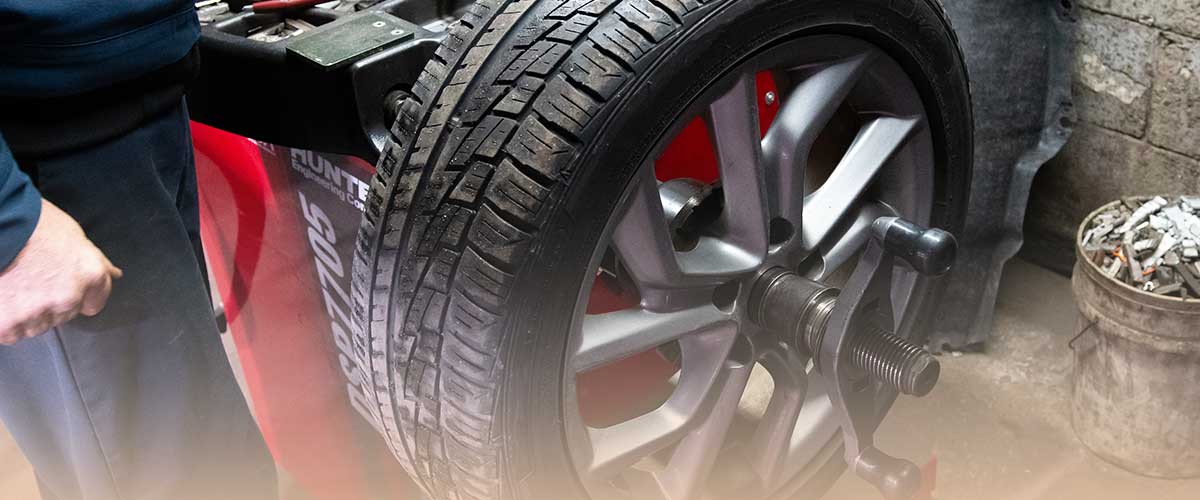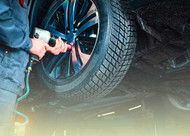What is a Wheel Balancer?
27th Aug 2024

Have you ever felt your car shaking while driving at high speeds? This could be a sign that your wheels are not properly balanced. A tire and wheel balancer is essential for a smooth ride, ensuring that the wheels' weight is evenly distributed.
Why do mechanics recommend a wheel balance check during tire rotation or replacement? Over time, wheels lose their balance due to wear and other factors. A wheel balancing machine helps pinpoint imbalances, enabling precise adjustments that enhance vehicle performance and extend tire life.
In this blog, we will explore how a wheel balancing machine works and why it’s crucial for maintaining your vehicle’s health. Learn about the benefits of regular wheel balancing and how it can save you from future car troubles.
What is a Wheel Balancer?
A wheel balancer is a specialized device that helps ensure a vehicle's wheels are perfectly balanced. This is crucial because unbalanced wheels can lead to vibrations, premature tire wear, and other driving issues. By using a wheel balancing machine, technicians can identify the exact spots where weights need to be added to achieve optimal balance.
Using this equipment, professionals can extend the life of tires and enhance the overall driving experience. The process involves mounting each wheel on a wheel balancing machine, which spins the tire to detect uneven weight distribution. Correcting these imbalances improves the smoothness of the ride and reduces stress on the vehicle’s suspension system.
How Do Wheel Balance Machine Works?
Wheel balancer machines are essential for maintaining smooth wheel and tire operations. They start by securing the wheel onto the balancer’s shaft, which simulates the vehicle’s hub. The machine then spins the wheel at speeds between 200 to 300 RPM, allowing sensors to detect imbalances.
The wheel balancer’s computer processes these readings to determine the exact imbalance locations and necessary counterweights. Technicians apply adhesive-backed lead or zinc weights to the designated spots on the wheel’s rim. These weights ensure that balance is maintained during vehicle operation.
After applying the weights, the wheel is re-spun to confirm that all imbalances have been corrected. If discrepancies persist, further adjustments are made. Modern wheel balancing machines feature automated data input, precise weight placement, and integrated diagnostics to streamline the balancing process and ensure optimal results.
Importance of Wheel Balancing
Wheel balancing is a crucial maintenance task that ensures a vehicle's wheels are in perfect harmony, providing a smooth, safe, and efficient driving experience. Here are some key reasons why regular wheel balancing is important:
1. Enhanced Tire Longevity
Imbalanced wheels lead to uneven tire wear, causing premature tire degradation and necessitating early replacement. Properly balanced wheels distribute wear evenly, significantly extending tire life.
2. Improved Ride Comfort
Unbalanced wheels can cause vehicle vibrations, especially at higher speeds, leading to a bumpy and uncomfortable ride. Balancing the wheels minimizes these vibrations, enhancing comfort for all passengers.
3. Increased Fuel Efficiency
Wheels that are not balanced create more drag and resistance as the vehicle moves, which requires more fuel to maintain speed. Ensuring that wheels are balanced helps in reducing fuel consumption.
4. Protection of Vehicle Components
Excessive vibrations caused by unbalanced wheels can also stress other vehicle components, including bearings, shocks, and the suspension system. By maintaining balanced wheels, you reduce the risk of premature wear and failure of these critical components.
Types of Wheel Balancers
When selecting the right tire wheel balancer for an automotive service center, it's important to consider the various types of wheel balancer machines available, each tailored to different service needs and levels of precision.
Here’s an overview of the primary categories:
1. Static Wheel Balancers
These machines are fundamental in setups where basic balancing is sufficient. Typically, static tire wheel balancers are used for lighter, less complex jobs, such as those involving motorcycle wheels. They provide a cost-effective solution for services not requiring high precision.
2. Dynamic Wheel Balancers
For comprehensive and precise balancing, dynamic wheel balancer machines are indispensable. These systems assess imbalances across multiple axes simultaneously, essential for ensuring smooth operation of vehicle wheels at higher speeds. Their sophisticated sensors and computing capabilities make them a staple in professional automotive workshops.
3. Laser Wheel Balancers
Incorporating advanced laser technology, these wheel balancer machines deliver unparalleled accuracy by visually indicating the exact placement of balancing weights. This precision is particularly beneficial for high-end performance vehicles, where even minor imbalances can affect driving dynamics.
4. Road Force Balancers
These are among the most sophisticated types of balancers available. Road force tire wheel balancers not only balance the wheel but also simulate road pressure to identify potential issues with tire uniformity and wheel runout. This technology is crucial for diagnosing complex problems that standard balancers might not detect.
5. Portable Wheel Balancers
Designed for mobility, these tire wheel balancers are suitable for use in various locations, such as track days or mobile repair services. They usually provide less precision than stationary models but offer convenience and flexibility for on-the-go balancing.
How To Choose The Right Wheel Balancer?
Selecting the ideal wheel balancer is crucial for any automotive service operation aiming to deliver top-tier service and ensure vehicle safety. Here’s a concise guide to help you make an informed decision tailored to your specific service needs and customer base.
1. Evaluate Balancer Type
Consider whether a static, dynamic, or road force balancer best suits your needs. Static balancers are cost-effective and suitable for simpler tasks, while dynamic balancers are essential for their precision in balancing both the lateral and vertical planes. Road force balancers offer the most thorough analysis by simulating actual driving conditions to identify even the most subtle imbalances and tire issues.
Dynamic and road force balancers are particularly beneficial for high-performance or luxury vehicles where precision is crucial. They can detect imbalances that might not be apparent with static balancers and are indispensable in professional automotive settings.
2. Determine Machine Capability
Assess the wheel size and weight capacity of the balancer to ensure it can accommodate the range of vehicles you service. This is crucial in avoiding the limitations that come with choosing a balancer that cannot handle larger or heavier wheels commonly found on SUVs and trucks.
The accuracy and speed of balancing are also paramount. A quicker balancer can increase throughput in a busy shop, but this should not compromise the accuracy needed for high-quality service. Especially for shops dealing with a high volume of customers, balancing speed paired with precision can significantly enhance operational efficiency.
3. Technology and Features
Advanced features such as automatic data entry, laser or LED indicators, and diagnostic capabilities can significantly enhance the efficiency and accuracy of wheel balancing. These features help in precisely locating the imbalance and suggest the exact weight placements, reducing the margin of error and the time taken per job.
Consider balancers equipped with modern interfaces and features that aid in easier operation and training. Touchscreen controls and intuitive software can simplify the balancing process, making it more accessible to new technicians and reducing errors in balancing procedures.
4. Budget and Return on Investment
Balancing the cost of a wheel balancer with the features it offers is crucial. Higher-end models with advanced features represent a significant investment but can provide a better return through more efficient operation and the capability to service a wider variety of wheels.
Evaluate the potential increase in customer satisfaction and repeat business due to higher service quality. Investing in a reliable, high-performance balancer can also reduce costs over time due to fewer operational issues and maintenance needs.
Shop Quality Tire Wheel Balancer With JB Tools
If you're in the market, looking for a quality tire wheel balancer, JB Tools offers you a diverse selection to meet the needs of any automotive workshop. Our inventory includes advanced models from leading manufacturers like KaTool USA, Dannmar, and Ranger to ensure you find the perfect fit for both performance and budget requirements.
Each product is backed by expert support, helping you make the most informed decision and maximize your investment in your service capabilities.

